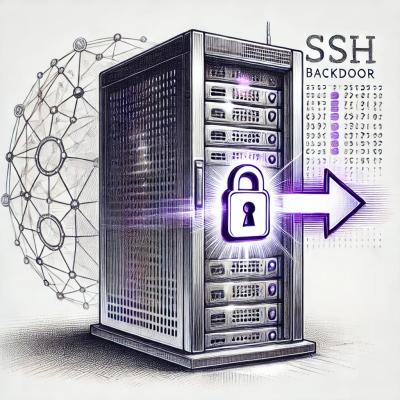
Research
Security News
Malicious npm Packages Inject SSH Backdoors via Typosquatted Libraries
Socket’s threat research team has detected six malicious npm packages typosquatting popular libraries to insert SSH backdoors.
A simple, maximally extensible, dependency minimized framework for building modern Ethereum dApps
web3-react DocumentationAt a high level, web3-react is a state machine which ensures that certain key pieces of data (the user's current account, for example) relevant to your dApp are kept up-to-date. To this end, web3-react uses Context to efficiently store this data, and inject it wherever you need it in your application.
The data conforms to the following interface:
interface Web3ReactContextInterface<T = any> {
activate: (
connector: AbstractConnectorInterface,
onError?: (error: Error) => void,
throwErrors?: boolean
) => Promise<void>
setError: (error: Error) => void
deactivate: () => void
connector?: AbstractConnectorInterface
library?: T
chainId?: number
account?: null | string
active: boolean
error?: Error
}
The documentation that follows is for @web3-react/core, the package responsible for managing this context. To understand where the data itself comes from, head over to the connectors/ folder.
Grab a fresh copy of react@>=16.8...
yarn add react
...and then install web3-react
yarn add @web3-react/core
web3-react@core API Referenceweb3-react relies on the existence of a Web3ReactProvider at the root of your application (or more accurately, at the root of the subtree which you'd like to have web3 functionality). It requires a single getLibrary prop which is responsible for instantiating a web3 convenience library object from a low-level provider.
getLibrary: (provider?: any, connector?: AbstractConnectorInterface) => any
import { Web3ReactProvider } from '@web3-react/core'
// import your favorite web3 convenience library here
function getLibrary(provider, connector) {
return new Web3Provider(provider) // this will vary according to whether you use e.g. ethers or web3.js
}
function App () {
return (
<Web3ReactProvider getLibrary={getLibrary}>
{/* <...> */}
</Web3ReactProvider>
)
}
If you're using Hooks (😇), useWeb3React will be your best friend. Call it from within any function component to access context variables, just like that. It accepts an optional key argument, if you're using multiple roots.
key?: string
import { useWeb3React } from '@web3-react/core'
function Component () {
const web3React = useWeb3React()
// ...
}
In some cases, your dApp may want to maintain >1 active web3 connections simultaneously. This could be for any number of reasons, including:
In cases like these, you'll likely want to create a second (or maybe even third, but probably not fourth) root, which will function exactly like another Web3ReactProvider (in fact, Web3ReactProvider uses createWeb3ReactRoot under the hood). It requires a key argument, used to identify the root to useWeb3React (or getWeb3ReactContext).
key: string
import { Web3ReactProvider, createWeb3ReactRoot } from '@web3-react/core'
// import your favorite web3 convenience library here
function getLibrary(provider) {
return new Web3Provider(provider) // this will vary according to whether you use e.g. ethers or web3.js
}
const Web3ReactProviderReloaded = createWeb3ReactRoot('anotherOne')
function App () {
return (
<Web3ReactProvider getLibrary={getLibrary}>
<Web3ReactProviderReloaded getLibrary={getLibrary}>
{/* <...> */}
</Web3ReactProviderReloaded>
</Web3ReactProvider>
)
}
If you're not using Hooks (😳), getWeb3ReactContext is your savior. It gives direct access to the context returned by createContext, which will unlock the use of contextType in class components, the Context.Consumer pattern, or whatever other render prop/HOC/etc. shenanigans your manager whose personal site still runs on PHP is making you write. It accepts an optional key argument to identify the root.
key?: string
import { getWeb3ReactContext } from '@web3-react/core'
const web3ReactContext = getWeb3ReactContext()
// ...
This is an error which can be used to inform users that they're connected to an unsupported network.
import { UnsupportedChainIdError } from '@web3-react/core'
// ...
function Component () {
const { error } = useWeb3React()
const isUnsupportedChainIdError = error instanceof UnsupportedChainIdError
// ...
}
Errors that occur during the initial activation of a connector (i.e. inside activate), are are handled in 1 of 4 ways:
web3-react context between when activate was called and when it resolved with the data required to complete the activation, errors are silently suppressed (in development mode, a warning will be logged to the console). This should really only happen in cases where activation takes a very long time and the user does something in the intervening time, such as activating another connector, deactivating the current connector, etc.throwErrors (the third argument to activate) is passed, errors will be thrown and should be handled in a .catch. No updates to the web3-react context will occur.onError (the second argument to activate) is passed, that function is called with the error. No updates to the web3-react context will occur.web3-react context (along with the connector).Errors that occur while a connector is set are handled in 1 of 2 ways:
onError function was passed, this function is called with the error. No updates to the web3-react context will occur.web3-react context.In all of these scenarios, note that calling setError will update the web3-react context. This can be called any time a connector is set, and it can be useful for e.g. manually triggering your app's handling of the web3-react error property.
Note: if an error is ever set in the web3-react context, and a connector triggers an update, the manager will attempt to revalidate all properties as if activate was called again, to recover from the error state.
FAQs
A simple, maximally extensible, dependency minimized framework for building modern Ethereum dApps
We found that porroiure demonstrated a healthy version release cadence and project activity because the last version was released less than a year ago. It has 1 open source maintainer collaborating on the project.
Did you know?

Socket for GitHub automatically highlights issues in each pull request and monitors the health of all your open source dependencies. Discover the contents of your packages and block harmful activity before you install or update your dependencies.

Research
Security News
Socket’s threat research team has detected six malicious npm packages typosquatting popular libraries to insert SSH backdoors.

Security News
MITRE's 2024 CWE Top 25 highlights critical software vulnerabilities like XSS, SQL Injection, and CSRF, reflecting shifts due to a refined ranking methodology.

Security News
In this segment of the Risky Business podcast, Feross Aboukhadijeh and Patrick Gray discuss the challenges of tracking malware discovered in open source softare.